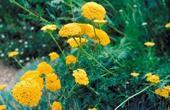Yarrow common( Acbillea millefolium)

Perennial plant of the Compositae family. It is distributed in almost all regions of Russia. It grows in meadows, in thickets of bushes, along the slopes of mountains, along roads, on the borders, along ravines. Folk names yarrow - Achilles, goose tongues, cricket grass, Jewish grass, tile grass and sheep's tongue.
Description
Plant height up to 50 cm, rhizome thin creeping branched. Stems single unbranched or several, erect, branching only in the upper part. Leaves lanceolate or linear, twice or thrice cicatrized. The stem and leaves are pubescent, silvery-green. Flowers are small, white or pink, collected in small baskets, which in turn form numerous complex shields. The plant is fragrant. Fruits are achenes. Blooms from late June to September, the fruits ripen in July-October.
Composition
The yarrow herb contains gliocosides apigenin and luteolon, amines holim, stachidrine, bitter substance achillein, essential oil, resins, organic acids, bitter, tannins, vitamin K.
Growing
Likes the sun, otherwise unpretentious, sowing in the spring, in rows at a distance of 40 cm, also propagates vegetatively by dividing old shrubs. Garden varieties of red and yellow flowers have less pronounced therapeutic properties. It grows in mixed culture with all herbaceous perennials. There are cases when yarrow caused a negative reaction in people predisposed to allergies to the family of Compositae.
Collect
Harvest the yarrow at the beginning of flowering plants, cut off the tops, tied in bundles and dried them in a ventilated room. Especially it should be noted that only air drying is allowed. Dry grass can be stored for 2 years.
Medicinal properties of
The yarrow herb has a high bactericidal activity, and the yarrow is also known as a good hemostatic. In a steam it is called a "blood" and is used for pulmonary, nasal, gastrointestinal, hemorrhoidal, uterine and external bleeding. It is quite common to use yarrow in gastrointestinal diseases, and also as bitterness to increase appetite. It is used in the treatment of gastritis, peptic ulcer of the stomach and duodenum, accompanied by digestive disorders and pain in the stomach and intestines.
Application
As a styptic, the yarrow is applied internally in the form of a liquid extract or a 1-tincture infusion.l.3 times a day, often for the preparation of the extract, the yarrow is combined with nettle dioecious, which also exerts a haemostatic effect. Rinse is used as an anti-inflammatory agent in case of mucous membrane disease. Yarrow is usually included in a variety of medicinal collections and teas. In cooking, the yarrow is used as a seasoning for cooking fatty foods( for example, goose fries, meat in pots, sausages).It smells good and promotes digestion. Thinly sliced young leaves mixed with soft cheese, sprinkled with salads, and added to soups and stews immediately before serving. Yarrow has a cleansing and soothing effect with oily, porous skin. It is also used in cosmetics for strengthening hair.
